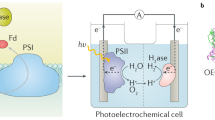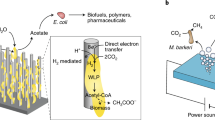Abstract
There is considerable interest in making use of solar energy through photosynthesis to create alternative forms of fuel. Here, we show that photosystem I from a thermophilic bacterium and cytochrome-c6 can, in combination with a platinum catalyst, generate a stable supply of hydrogen in vitro upon illumination. The self-organized platinization of the photosystem I nanoparticles allows electron transport from sodium ascorbate to photosystem I via cytochrome-c6 and finally to the platinum catalyst, where hydrogen gas is formed. Our system produces hydrogen at temperatures up to 55 °C and is temporally stable for >85 days with no decrease in hydrogen yield when tested intermittently. The maximum yield is ∼ 5.5 µmol H2 h−1 mg−1 chlorophyll and is estimated to be ∼25-fold greater than current biomass-to-fuel strategies. Future work will further improve this yield by increasing the kinetics of electron transfer, extending the spectral response and replacing the platinum catalyst with a renewable hydrogenase.
This is a preview of subscription content, access via your institution
Access options
Subscribe to this journal
Receive 12 print issues and online access
$259.00 per year
only $21.58 per issue
Buy this article
- Purchase on Springer Link
- Instant access to full article PDF
Prices may be subject to local taxes which are calculated during checkout






Similar content being viewed by others
References
Tsoskounogiou, M., Ayerides, G. & Tritopoulou, E. The end of cheap oil: current status and prospects. Energy Policy 36, 3797–3806 (2008).
Moore, A. Short-circuiting our fossil fuel habits. Could a more direct harnessing of photosynthesis become an alternative to natural oil, coal and gas? EMBO Rep 6, 205–208 (2005).
Pimentel, D. & Patzek, T. Ethanol production using corn, switchgrass and wood; biodiesel production using soybean and sunflower. Natural Resources Res. 14, 65–76 (2005).
Ghirardi, M. L. et al. Microalgae: a green source of renewable H2 . Trends Biotechnol. 8, 506–511 (2000).
Ghirardi, M. L. et al. Hydrogenases and hydrogen photoproduction in oxygenic photosynthetic organisms. Ann. Rev. Plant Biol. 58, 71–91 (2007).
Deisenhofer, J. & Michel, H. High-resolution structures of photosynthetic reaction centers. Ann. Rev. Biophys. Biophys. Chem. 20, 247–266 (1991).
Golbeck, J. H. Shared thematic elements in photochemical reaction centers. Proc. Natl Acad. Sci. USA 90, 1642–1646 (1993).
Iwata, S. & Barber, J. Structure of photosystem II and molecular architecture of the oxygen-evolving centre. Curr. Opin. Struct. Biol. 14, 447–453 (2004).
Kalman, L., Williams, J. C. & Allen, J. P. Comparison of bacterial reaction centers and photosystem II. Photosynth. Res. 98, 643–655 (2008).
Grotjohann, I. & Fromme, P. Structure of cyanobacterial photosystem I. Photosynth. Res. 85, 51–72 (2005).
Nelson, N. & Ben-Shem, A. The structure of photosystem I and evolution of photosynthesis. Bioessays 27, 914–922 (2005).
Jensen, P. E. et al. Structure, function and regulation of plant photosystem I. Biochim Biophys. Acta 1767, 335–352 (2007).
Barber, J. Photosystem II: the engine of life. Q. Rev. Biophys. 36, 71–89 (2003).
Evans, B. R. et al. Enhanced photocatalytic hydrogen evolution by covalent attachment of plastocyanin to photosystem I. Nano Lett. 4, 1815–1819 (2004).
Millsaps, J. F., Bruce, B. D., Lee, J. W. & Greenbaum, E. Nanoscale photosynthesis: photocatalytic production of hydrogen by platinized photosystem I reaction centers. Photochem. Photobiol. 73, 630–635 (2001).
Ihara, M. et al. Photoinduced hydrogen production by direct electron transfer from photosystem I cross-linked with cytochrome c(3) to [NiFe]-hydrogenase. Photochem. Photobiol. 82, 1677–1685 (2006).
Ihara, M. et al. Light-driven hydrogen production by a hybrid complex of a [NiFe]-hydrogenase and the cyanobacterial photosystem I. Photochem. Photobiol. 82, 676–682 (2006).
Das, R. et al. Integration of photosynthetic protein molecular complexes in solid-state electronic devices. Nano Lett. 4, 1079–1083 (2004).
Jordan, P. et al. Three-dimensional structure of cyanobacterial photosystem I at 2.5 Å resolution. Nature 411, 909–917 (2001).
Evans, P. K. & Krogmann, D. W. 3 c-type cytochromes from the red alga Porphyridium cruentum. Archives Biochem. Biophys. 227, 494–510 (1983).
Ho, K. K., Ulrich, E. L., Krogmann, D. W. & Gomezlojero, C. Isolation of photosynthetic catalysts from cyanobacteria. Biochim. Biophys. Acta 545, 236–248 (1979).
Nakamura, Y. et al. Complete genome structure of the thermophilic cyanobacterium T. elongatus BP-1. DNA Res. 9, 123–130 (2002).
Cho, Y. S., Wang, Q. J., Krogmann, D. & Whitmarsh, J. Extinction coefficients and midpoint potentials of cytochrome c(6) from the cyanobacteria Arthrospira maxima, Microcystis aeruginosa and Synechocystis 6803. Biochim. Biophys. Acta-Bioenergetics 1413, 92–97 (1999).
Anta, J. A., Casanueva, F. & Oskam, G. A numerical model for charge transport and recombination in dye-sensitized solar cells. J. Phys. Chem. B 110, 5372–5378 (2006).
Duran, R. V., Hervas, M., De la Rosa, M. A. & Navarro, J. A. In vivo photosystem I reduction in thermophilic and mesophilic cyanobacteria: the thermal resistance of the process is limited by factors other than the unfolding of the partners. Biochem. Biophys. Res. Commun. 334, 170–175 (2005).
Du, H. B., Fairbridge, C., Yang, H. & Ring, Z. The chemistry of selective ring-opening catalysts. Appl. Catalysis A—General 294, 1–21 (2005).
Hegedus, L. & Mathe, T. Hydrogenation of pyrrole derivatives—Part V. Poisoning effect of nitrogen on precious metal on carbon catalysts. Appl. Catalysis A—General 226, 319–322 (2002).
Irandoust, S. & Edvardsson, J. Poisoning of nickel-based catalysts in fat hydrogenation. J. Am. Oil Chemists Soc. 70, 1149–1156 (1993).
Grimme, R. A., Lubner, C. E., Bryant, D. A. & Golbeck, J. H. Photosystem I/molecular wire/metal nanoparticle bioconjugates for the photocatalytic production of H2. J. Am. Chem. Soc. 130, 6308–6309 (2008).
Acknowledgements
This work was supported by a National Science Foundation (NSF) Nanoscience Interdisciplinary Research Team (NIRT) award to B.D.B. (DBI-0403781) and an NSF Sustainable Science Grant (CBET 0828615) award to P.D.F. and B.D.B. A SARIF Award and Science Alliance Award provided additional support to P.D.F. and B.D.B. The authors would like to acknowledge the technical help of J. Dunlap, A. Godman, C. Pacquet, P. Mahbubani and S. Wright, and also thank G. Alexandre, B. Evans, E. Greenbaum, D. Harrell, L. Johnson and B. Mullin for their input.
Author information
Authors and Affiliations
Contributions
I.J.I. performed all the hydrogen evolution experiments, provided data analysis and assisted in manuscript preparation. M.V. grew and maintained T. elongatus, isolated and characterized PSI, assisted in cytochrome-c isolation, conducted thermostability measurements, composed all the figures, provided data analysis and manuscript preparation. N.M. cloned and developed the over-expression system for cytochrome-c and provided cytochrome-c for hydrogen evolution experiments. H.O.N. supervised hydrogen evolution experiments, helped coordinate the hydrogen experimentation, and participated in data analysis and manuscript preparation. P.F. coordinated hydrogen evolution experiments, supported I.J.I. and N.M., and participated in data analysis and manuscript preparation. B.D.B. provided overall coordination of the project, supervised the microbiology, molecular biology and biochemistry, provided support for M.V. and N.M., and participated in data analysis and manuscript preparation as corresponding author.
Corresponding author
Supplementary information
Supplementary information
Supplementary information (PDF 1300 kb)
Rights and permissions
About this article
Cite this article
Iwuchukwu, I., Vaughn, M., Myers, N. et al. Self-organized photosynthetic nanoparticle for cell-free hydrogen production. Nature Nanotech 5, 73–79 (2010). https://doi.org/10.1038/nnano.2009.315
Received:
Accepted:
Published:
Issue Date:
DOI: https://doi.org/10.1038/nnano.2009.315
This article is cited by
-
Prolonged hydrogen production by engineered green algae photovoltaic power stations
Nature Communications (2023)
-
Algal cell bionics as a step towards photosynthesis-independent hydrogen production
Nature Communications (2023)
-
Photosynthetic hydrogen production by droplet-based microbial micro-reactors under aerobic conditions
Nature Communications (2020)
-
Cyanobacterial in vivo solar hydrogen production using a photosystem I–hydrogenase (PsaD-HoxYH) fusion complex
Nature Energy (2020)
-
Polymer-chlorella cells conjugating with aggregation-induced functionality switch towards hydrogen evolution
Science China Technological Sciences (2020)



